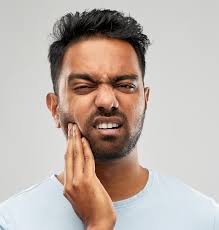Temporomandibular Joint (TMJ) Disorder and Jaw Pain
TMJ disorder can cause pain and discomfort in the jaw area when we talk or eat. This makes it tough to enjoy meals, speak, or even smile. Even doing simple tasks, like yawning, can hurt. The constant pain might lead some to avoid eating certain foods, or other enjoyable activities such as, singing, cheering on your favourite sports team and even sleep!
The intricate web of muscles, ligaments, and nerves that connects the neck and jaw means that issues in one area can affect the other. Misalignments in the cervical spine can lead to imbalances and tension that radiate into the jaw, contributing to TMJ symptoms. The exact origin of TMJ pain is not always easy to find. Whether it’s an injury near the temporomandibular joint, the cause of pain may not always be so seemingly direct, but recovery and healing are possible through a variety of treatments, including Chiropractic, Acupuncture, and Cold Laser Therapy.
The exact origin of TMJ pain is not always easy to find. Whether it’s an injury near the temporomandibular joint, the cause of pain may not always be so seemingly direct, but recovery and healing are possible through a variety of treatments, including Chiropractic, Acupuncture, and Cold Laser Therapy.
Stress and poor posture often put pressure on the spine and neck, especially noted in desk workers who are focused on the computer work and often forget the guidelines of ergonomics. Proper jaw alignment depends on coordination between muscles, ligaments, discs, bones, nerves and teeth. Proximity to the teeth and ears often leaves pain sufferers thinking that their pain is associated with these parts of the body. In fact, they are experiencing what is pain in this nearby joint. Pain can sometimes even switch sides, further confusing TMJ pain sufferer.
Here are a few factors that can increase the risk of TMJ pain:
• Stress
• Poor posture
• Arthritis
• Injury to the jaw
• Grinding (bruxism) or clenching of the teeth, misaligned jaw
• Tissue diseases affecting the temporomandibular joint TMJ disorder manifests in a variety of symptoms that impact daily life. Recognizing the signs of temporomandibular joint dysfunction is crucial for prompt diagnosis and treatment to relieve discomfort.
TMJ disorder manifests in a variety of symptoms that impact daily life. Recognizing the signs of temporomandibular joint dysfunction is crucial for prompt diagnosis and treatment to relieve discomfort.
The following are symptoms that patients often experience:
• Intense jaw discomfort and tenderness moving to the cheeks, neck, and shoulders.
• Clicking, popping or rough grinding sounds/sensations when opening or closing the mouth
• Jaw tenderness or tiredness after chewing or talking
• Stuck jaw that cannot open entirely or difficulty biting or chewing food
• Frequent headaches or migraines
• Jaw pain or tenderness on one or both sides, especially at one of the temporomandibular joints
• Facial pain (usually achy)
• Blurred vision
• Earache, pain in or around your ear, a fullness of the ears
• Tooth pain, especially in the absence of cavities
• Stiff or tight neck or shoulders
Here are some steps for minimizing TMJ symptoms while receiving care from your chiropractor:
• Avoid chewing gum, nail-biting, and eating extra-chewy or hard foods.
• Try to keep your whole body relaxed and improve your overall posture.
• Massage your jaw muscles and the sides of your head above the ears.
• Practice leaving space between your teeth.
• As much as possible, avoid opening your mouth.
• Wear a bite guard while sleeping.
Chiropractic care focuses on the relationship between the spine and the nervous system, emphasizing the body’s ability to heal itself. Chiropractors believe that proper alignment of the spine promotes overall well-being, and this extends to addressing conditions like TMJ.
Spinal Adjustments: Chiropractors use manual adjustments to realign the spine, including the cervical spine. A hand-held adjusting tool can also be used to effectively gap open the TMJ. These adjustments aim to reduce tension and improve the function of the joints, potentially alleviating TMJ symptoms.
Soft Tissue Techniques: Chiropractors may incorporate soft tissue techniques to address muscle tension and trigger points in the neck and jaw area. This can help relax the muscles and improve joint mobility.
Electro-Acupuncture: Acupuncture acts locally both in muscle relaxation and pain management. It relieves pain and discomfort by relaxing muscles and releasing endorphins (natural pain-killing chemicals) and serotonin (the “happy” hormone that promotes feelings of well-being). It also improves the action of the muscles that open and close the jaw by using facial acupuncture points to stimulate the temporalis muscle. It releases TMJ trigger points in the masseter, lateral/medial pterygoid, and temporalis muscles that can help to reduce pain and increase range of motion in the TMJ. Acupuncture relaxes the muscles of the jaw and face which are often contracted when you are stressed. Acupuncture also increases the production of cortisol which is a chemical that helps to control inflammation in the body.
Cold Laser Therapy: Low-Level Laser Therapy (LLLT) is a non-invasive therapy that works through a photochemical effect. It facilitates the release of endogenous opioids, increases tissue repair, vasodilation and pain threshold, and decreases inflammation.
Postural Recommendations: Chiropractors provide guidance on maintaining proper posture to prevent ongoing strain on the neck and jaw. This may include exercises and lifestyle adjustments to support long-term relief.




